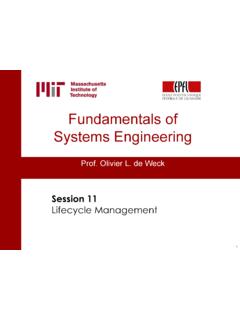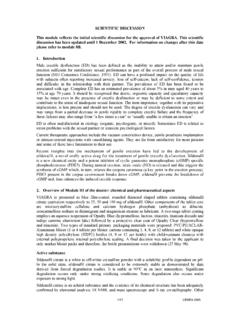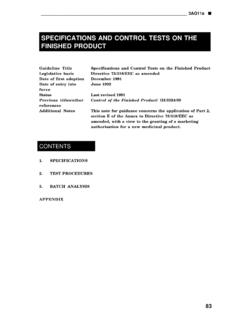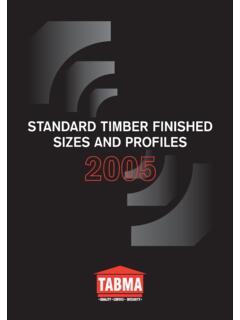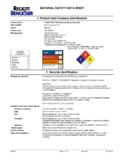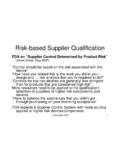Transcription of Heijunka Product & Production Leveling
1 Heijunka Product & Production Leveling Module Mark Graban, LFM Class of 99, Internal Lean Consultant, Honeywell Presentation for: Summer 2004 iAmy Reyner, Kweku Fleming Lean/Six Sigma Systems MIT Leaders for Manufacturing Program (LFM) These materials were developed as part of MIT's course on "Lean/Six Sigma Systems." In some cases, the materials were produced by the lead instructor, Joel Cutcher-Gershenfeld, and in some cases by student teams working with LFM alumni/ae. Where the materials were developed by student teams, additional nputs from the faculty and from the technical instructor, Chris Musso, are reflected in some of the text or in an appendix 6/2 [/Overview Learning Objectives Introduce and demonstrate the concept of Heijunka Understand the benefits of Heijunka Understand how to apply Heijunka in a typicalmanufacturing process Identify how Heijunkainteracts with other Lean tools.]
2 Session Design (20-30 min.) Part I: Introductions (1-2 min.) Part II: Definition of Heijunka and identification of its role in Lean manufacturing. (3-5 min.) Part III: Study models of Heijunka in use. Step through an example of Heijunka (7-13 min.) Part IV: Benefits and Trade-offs associated with Heijunka & Common Disconnects, (5 7 min.) Part V: Re-Cap and Concluding Comments (2-3 min.) 9/04 --LFM Students] Lean Six Sigma Systems, LFM, MIT Part I: Introduction Part II: Concepts Part III: Application Part IV: Disconnects Part V: Conclusion 6/3 [/ Heijunka Key Concepts thesis by Sean Hilbert Heijunka is defined as The distribution of Production volume and mix evenly over time1 predictable manufacturing process Heijunka is generally used in combination with other key Lean principles to stabilize value flow manufacturing process 1 9/04 --LFM Students] Lean Six Sigma Systems, LFM, MIT Adapted from MIT LFM Part I: Introduction Part II: Concepts Part III: Application Part IV: Disconnects Part V.
3 Conclusion Heijunka converts uneven Customer Pull into even and Heijunka is a core concept that helps bring stability to a Lean Production Simplified, Pascal Dennis 6/4 [/The Need for Heijunka changeovers, but usually result in: long lead times, swelli mix i A more level 9/04 --LFM Students] Lean Six Sigma Systems, LFM, MIT There are a number of reasons for implementing Heijunka : Product Leveling large batches of the same Product may reduce set-up times and ng inventories greater opportunities for defects. excessive idle time and/or overtime. An even of products is critical to avoiding these impacts Production Leveling Remember the Beer Game ? Fluctuationsn demand ( Boller or Bullwhip Effect) are often highly amplified and delayed throughout the supply chain.
4 Responding to fluctuating customer demand can result in increased overtime or idle time. Variable Production schedules can be stressful = Unhappy workers. Production volume eases these complications 6/5 [/Supplier produces 4500 based on demand. Our workers begin to revolt due to demanding and unpredictable work. Start taking long lunches at Chotchsky s Supplier sees sharp decline in demand. so produces far less. Supplier sees increase in demand. Excited to sell more Product , significantly increases Production Supplier notices demand. Lowers of inventory. Supplier goes out of business due to inventory and workforce management costs. Workers for our company quit to become construction workers. 9/04 --LFM Students] Lean Six Sigma Systems, LFM, MIT last year s avg.
5 Has extra inventory, steady decrease in Production to get rid Chasing Demand The Bullwhip Effect 6/6 [/What is Production Leveling ? A Simple Example 17,316 16,866 16,326 4 4 4 = = = 4,217 4,329 4,082 9/04 --LFM Students] Lean Six Sigma Systems, LFM, MIT Part I: Introduction Part II: Concepts Part III: Application Part IV: Disconnects Part V: Conclusion 6/7 [/JIT vs. Production Leveling given period of level Production . for short periods of higher demand* Predictable work schedules Supply Chain. Meet customer demand upon varying customer demand backupstreams Bullwhip Effect 9/04 --LFM Students] Lean Six Sigma Systems, LFM, MIT Meet customer demand in total over a Finished Goods Inventory to make up Stability transmitted to Supplier Reduces Inventory over the entire Overtime savings Happy people Upstream request ( just in time ) Reduced Finished Goods Inventory Unpredictable work schedules High variability for Supplier Cascade Overtime occasionally 6/9/04 --8 [/1 2 3 4 5 6 7 8 Week Batching Product Leveling Customer waiting for supplier.]
6 What is Product Leveling ? Extended downtime for machine conversions. ly. flexibly tooled. Customers are happy with steady and predictable flow happy with even work flow We make A s, B s, and C s: AA B C LFM Students] Lean Six Sigma Systems, LFM, MIT Product A is tired of waiting. Goes to another Workers go home earConversion times are reduced and machines are of Product . Workers are 6/9 [/Challenges for Heijunka Technical Factors Heijunka Leveling are often With Heijunka , there is a needfor larger Finished GoodsInventory. This can be seen asantithetical to Lean mission. Can not immediately be predictable environment,customer data. Predicting demand isimperfect. process. Social Factors Heijunka depends on Direct information about projected(future) events.
7 Explaining why it s importantto do standardized work Reduces operator flexibilitywhich can draw resistance Requires discipline and muchmore planning 9/04 --LFM Students] Lean Six Sigma Systems, LFM, MIT Tools needed for large-scale lacking. Obsolescence of finished parts implemented requires Bad data can ruin customer contact and accurate before implementing HJ. Part I: Introduction Part II: Concepts Part III: Application Part IV: Disconnects Part V: Conclusion 6/10 [/Concluding Comments If Takt time is described as the heart beat of Lean implementation, then Heijunka is the deep breathing exercise of Lean that brings internal and external suppliers. Heijunka , You won t be HAPPY without it!
8 2 2 9/04 --LFM Students] Lean Six Sigma Systems, LFM, MIT stability (calm) to the manufacturing process, spreading it upstream to The Toyota Production System: Leaner Manufacturing for a Greener Planet. Published 1998, Part I: Introduction Part II: Concepts Part III: Application Part IV: Disconnects Part V: Conclusion 6/11 [/Appendix: Instructor s Comments and Class Discussion for Heijunka reveals the limits of the label lean and points to a knowledge-driven process for ensuring stability, flow and pull Consider the level at which Heijunka expertise needs to be Most lean operations strike a balance between Product Leveling and Production Leveling really is some balance between the two Heijunka requires a lot of data, and can be tough to deal with Heijunka is not necessarily useful for businesses with level and dependable demand.
9 9/04 --LFM Students] Lean Six Sigma Systems, LFM, MIT It is still about ensuring the customer has what they want, when they want it at the price they are willing to pay established plant-wide, departments, individual work areas? Good not to have inventory, good to meet demand, but there Worker happiness is an important measure of Heijunka success 6/12 [/Appendix: Instructor s Guide 2-3 min9 You won t be happy without Heijunka 1-2 min01 unfinished inventories 2-4 min8 inventory. It is iing 4-7 3 1-2 Slide Key Concepts3-5 min Distributing time. learning objectives 2-3 min Additional Talking PointsTopicTime 9/04 --LFM Students] Lean Six Sigma Systems, LFM, MIT Imperfect Data, Large Safety Inventory, Increased Planning Required, Challenges for Heijunka Heijunka is the Deep Breathing Exercise for the Manufacturing Process Conclusion Product Leveling : Long Lead times, large Heijunka Product Leveling seeks to break down batches into smaller interspersed runs What is Product Leveling ?
10 Heijunka levels Production , JIT results in level Safety stock is a key to Heijunka . Heijunka is not implemented in a vacuum. effective when ntegrated with other lean tools, reduced set-ups, Takt time, Kanban planning etc. The Need for Heijunka What is Production Leveling ? JIT vs. Heijunka Level7-13 min Heijunka converts uneven customer pull into predictable value flow. Converts inefficient batching processes into coordinated multi-tasking Heijunka is Production Leveling Production volume or Production mix evenly over Introduction, overview and Part I: Introduction Part II: Concepts Part III: Application Part IV: Disconnects Part V: Conclusion









